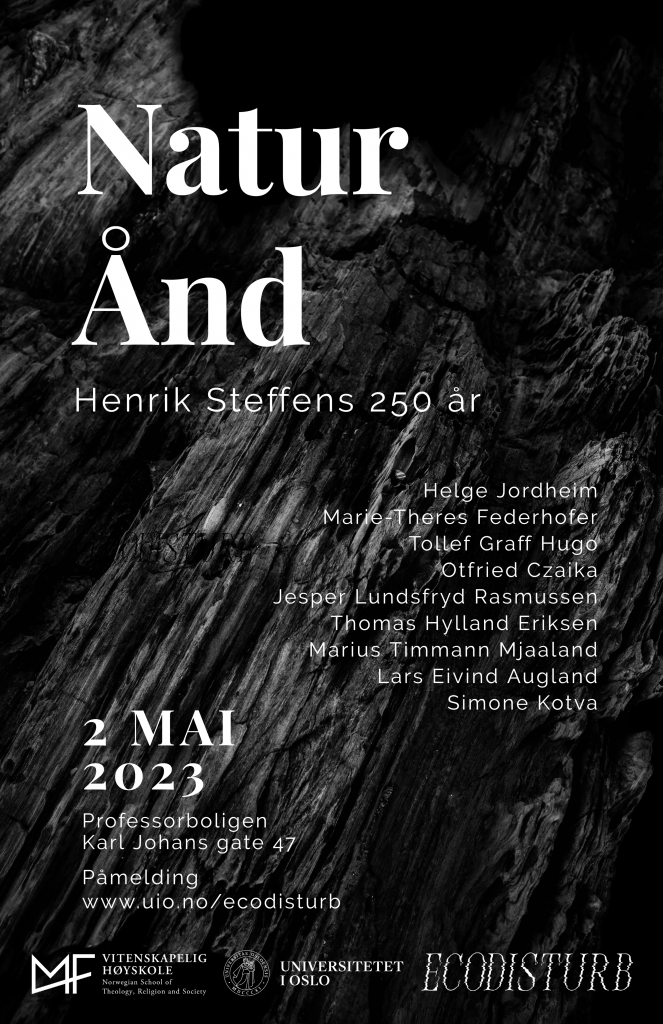‘Henrik Steffens 250 år: NATUR | ÅND’. Conference on Henrik Steffens in Oslo 2. may.
ÅPENT SYMPOSIUM: Henrik Steffens 250 år
Henrik Steffens (1773-1845) er en nøkkelfigur for å forstå naturtenkningen i den romantiske perioden i Norden, som også har preget hvordan vi oppfatter naturen. Steffens var en inspirerende og grenseoverskridende tenker: geolog og filosof, teolog og dikter. Inspirert av Schellings naturfilosofi og tidlig industrialisering ønsket han å la naturen komme til orde på sine egne premisser:
«Jeg ønsket å vise hvordan naturen, ikke bare i sin helhet, men også i sine enkeltheter, kan forstås på sine egne premisser.»
Den 2. mai inviterer UiO:Norden, MF og ECODISTURB til åpent symposium om Steffens og vår tid. Henrik Steffens ble født i Stavanger 2. mai 1773 og vokste opp med en norsk mor og tysk far. Hans tenkning og virker forbinder Norge, Danmark og Tyskland og åpner for nye refleksjoner omkring sammenhengen mellom natur og ånd i en tid preget av klimakrise, akselerasjon og naturtap, en epoke som går under navnet antropocen.
To mark 250 years since his birth, the UiO:NORDIC project ECODISTURB are organizing a workshop on the life, work and thought of Henrik Steffens (1773-1845).
Henrik Steffens is a key thinker in the early Romantic period, drawing on Schelling’s reaction to Kantian abstraction and the early industrialization. In his Naturphilosophie (Philosophy of nature), developed from 1799 to 1810, he intends to let nature speak with its own voice, by giving expression to its self-reflection: “I wanted to show how nature, not only as a whole, but also in its particularities, can be conceived of in its own terms.”
This workshop is dedicated to thinking with Steffens today: in a time of rapidly deteriorating biomes, what resources, challenges and possibilities is thrown up by his philosophy of nature? The symposium is held in Norwegian.
Kom og hør
Helge Jordheim (Kulturhistorie, UiO)
Marie-Theres Federhofer (Tysk og kulturstudier, UiT)
Tollef Graff Hugo (Religionsfilosofi, MF)
Otfried Czaika (Kirke- og kulturhistorie, MF)
Jesper Lundsfryd Rasmussen (Naturhistorie, Københavns Universitet)
Thomas Hylland Eriksen (Antropologi, UiO)
Marius Timmann Mjaaland (Filosofi og teologi, UiO)
Lars Eivind Augland (Mineralogi, UiO)
Simone Kotva (Teologi og miljøetikk, UiO)
Program
0900 Fremmøte
0915 Velkommen. Hilsener
0930 Helge Jordheim: : Akselerasjon og dyp tid: Steffens’ naturhistoriske øyeblikk og vårt eget
1000 Marie-Theres Federhofer: : Jordas Bildungsgeschichte. Geoantropologi hos Henrik Steffens
1030 Samtale
1100 Pause
1115 Tollef Graff Hugo: Henrik Steffens om universitetets idé; Otfried Czaika: Steffens syn på lutherdomen – några anmärkningar; Jesper Lundsfryd Rasmussen: Totalitet og anerkendelse af naturen. En udfordring til diskussionen af det antropocæne fra Henrik Steffens
1230 Pause
1315 Thomas Hylland Eriksen: Overoppheting og nedkjøling – et ulykkelig ekteskap. Om tidsregimer og skalakollisjoner
1345 Marius Timmann Mjaaland: To tidsaldre: Ånden, naturen og det nye mennesket
1415 Samtale
1445 Kaffe
1500 Lars Eivind Augland: Neptunsk geognosi, kjemi og oryctognosi: Steffens’ plass i en gryende geovitenskap; Simone Kotva: Natur och andlighet i Antropocen
1530 Samtale om Steffens og vår tid
1600 Avslutning
